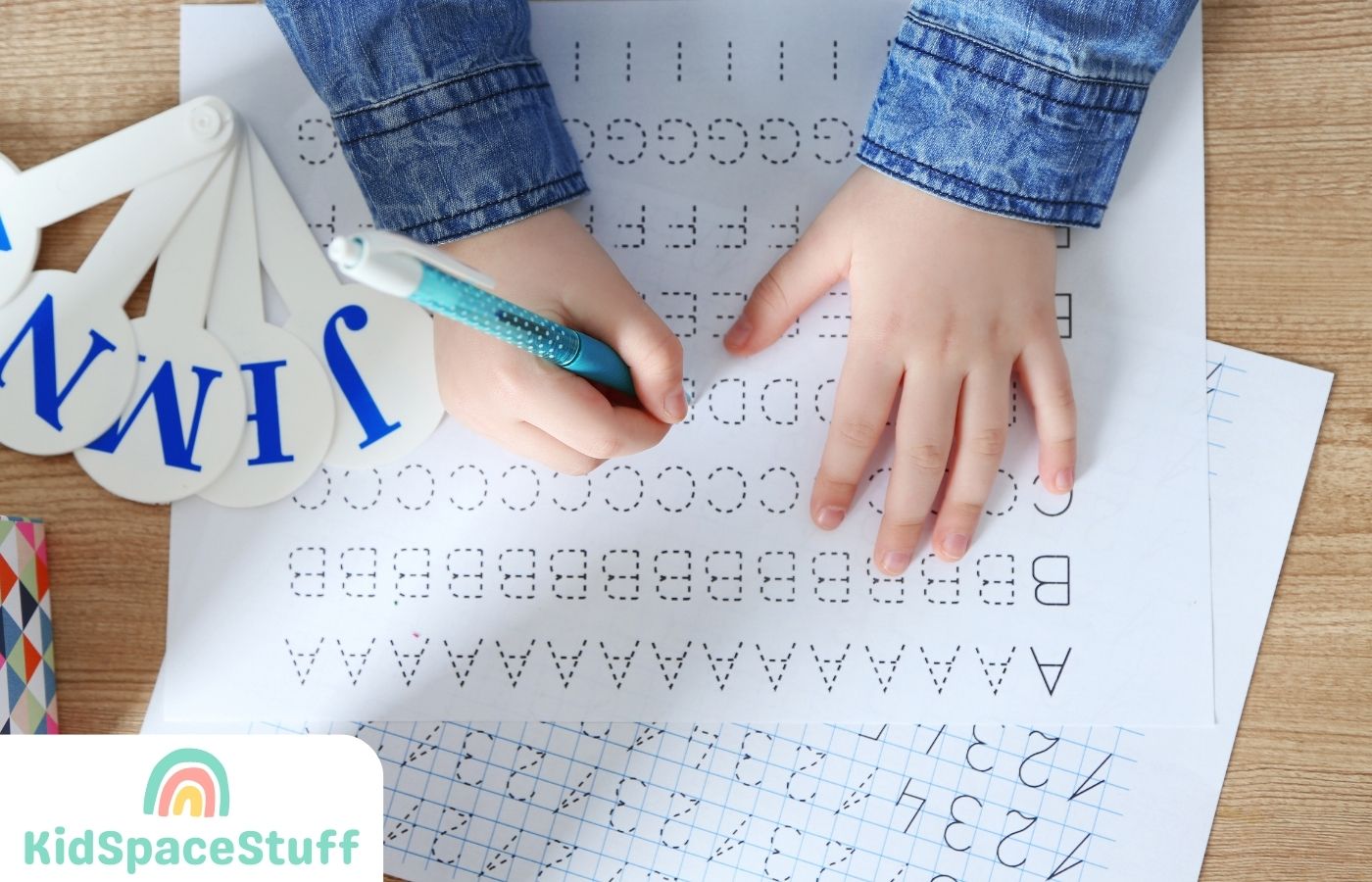As a mother of multiple children, each with their unique quirks and strengths, I’ve observed and guided my brood through many of their “firsts”.
One that particularly stands out is when they first learn to write their names.
It’s a beautiful process that comes with a sense of pride for them and a moment of awe for me. So let’s dive into this fascinating process together!
Key Takeaways:
- Learning to write their name is important for children as it helps them develop early pre-writing skills and introduces them to the writing process. In most cases, kids will learn to write their name between the ages of 3 and 6, although it will vary from child to child.
- To prepare children for writing, it is crucial to focus on building their fine motor control and hand strength, developing their visual motor skills, and providing them with developmentally appropriate writing utensils.
- Teaching strategies and tips include encouraging independent writing, introducing the writing process, and utilizing technology and sensory activities to make the learning experience engaging and interactive.
Basics of Teaching Your Kids to Write
Learning to write their name is an essential milestone for every child. It forms the cornerstone of their literacy journey. It’s amazing to see how a simple task like this can open doors to cognitive development, self-identification, and self-expression. It’s like watching your child take their first steps towards their educational and personal growth, something truly heartwarming for a mother like me.
Why Your Little One’s Scribbles Matter
Learning to write their name is far more than just a fun activity for your child. This skill gives them a sense of ownership and identity. It’s as if they are marking their territory in this vast world, saying, “I’m here, and I matter!” Plus, it’s an early step towards independence, a significant contributor to boosting their confidence, just like learning to whistle or tie their shoes.
The Fascinating Stages of Writing Development
Before they can pen down their names, children need to progress through various stages. As a mother, you’ll see them grow from an innocent scribbler to a competent writer. Starting with basic scribbling, they gradually learn to form shapes and lines, leading them to the gateway of literacy – capital letters. It’s amazing to see how each stage builds upon the previous one, refining their writing techniques bit by bit.
Fun Ways to Boost Fine Motor Skills
In order to learn to write, you’ll need to encourage activities that foster fine motor control and hand strength. I’ve found that tasks requiring precise hand movements, like cutting with scissors or molding clay, can work wonders in improving their dexterity. Similarly, visual motor skills can be developed through enjoyable exercises like tracing or connecting dots.
Choosing the Right Tools
Using the right writing tools is also crucial.
Just like you wouldn’t give an oversized basketball to your toddler, giving them the right-sized pencil or marker can make their learning process smoother.
Providing your child with developmentally appropriate writing utensils will facilitate a proper grip and control, setting them up for success.
The Joy of Independent Writing

Give your child the freedom to express their creativity through independent writing.
It plays a pivotal role in honing their skills and building confidence in their abilities. Introducing the concept of the writing process and using technology tools can further enhance engagement and motivation.
The Big Transition: From Tracing to Writing
As your child matures, they’ll transition from tracing to independently writing their name – a huge milestone indeed!
As a mother, I always make sure to guide them on correct letter formation and proper spelling, as it strengthens their writing competency. For my older kids, I ensure to aid them in refining their writing skills through editing and revising, helping them articulate their thoughts more effectively.
Patience is a Virtue
Remember, recognizing signs of developmental readiness is key. Every child is unique, and they develop at their own pace. Creating a positive environment that celebrates effort rather than focusing solely on outcomes can instill enthusiasm and confidence in them.
A Closer Look at the Writing Process
Writing for kids is a fascinating journey that starts with them learning how to hold a writing tool and making lines and shapes, then advancing to the big leagues – writing capital letters! Their little fingers need fine motor control and strength to handle the pen.
Step 1: Fueling Fine Motor Skills
One of the first things you can do to help your child prepare for writing is to engage them in activities that boost their fine motor skills. Think of this as the warm-up exercises before the big game!
Finger painting is one such activity that my children absolutely adore. As they glide their fingers across the paper, they are unknowingly working on their hand strength and control, key ingredients for good writing.
Similarly, playing with playdough or manipulating small objects, like beads, can greatly enhance their dexterity. These fun exercises are a covert training ground for the precise hand movements they’ll soon need for writing.
Step 2: Trace to Ace

Once your child has had ample fun (and practice) with these activities, it’s time to introduce them to the wonderful world of tracing. Provide them with age-appropriate tracing worksheets or materials. Start with simple lines and then slowly progress to more complex patterns.
Tracing helps children control their hand movements, while simultaneously developing visual-motor coordination. It’s like they are rehearsing for their big stage debut – writing their name!
Step 3: Mastering Straight Lines
Drawing straight lines is the next milestone on this journey. You can guide your child in drawing straight lines using a ruler or any straight edge as a template. Start with vertical and horizontal lines first. Once they get comfortable with these, you can introduce diagonal lines.
This step is crucial as it helps them gain confidence in their writing abilities and develops their spatial awareness. It’s amazing to see their little faces beam with pride once they can draw a straight line!
Step 4: The Curve Appeal
After they’ve mastered straight lines, it’s time for a curveball – quite literally! Start introducing your child to curved lines by suggesting they try to draw circles, arcs, or waves. Use templates or visual aids if necessary.
Help them understand the difference between curves and angles. This step adds another layer of complexity to their drawing skills and opens the doors to an array of new shapes they can create!
Step 5: Shaping their Skills
The final step in this pre-writing journey is introducing shapes. Combining different elements they’ve learned, your child can now start forming simple shapes like squares, triangles, rectangles, and circles.
Visual aids or templates can be a great tool to assist them. But remember, it’s more important that they enjoy the process rather than getting the shapes perfect.
Remember, every child moves at their own pace. What matters most is that they enjoy the journey and grow in confidence. Always celebrate their efforts and improvements. This will build a positive association with writing and learning in general, paving the way for a lifelong love for learning!
Encouraging Independent Writing
Encourage your child to practice writing independently. Technology and sensory activities can enhance their learning experience. With time, they progress from tracing to forming letters on their own. I’ve found that guiding them on correct letter formation and spelling sets a strong foundation for their future writing skills.
Understanding Developmental Milestones
Recognizing when your child is ready to start writing their name is paramount. Trust me, it’s not worth it to pressure them if they’re not developmentally ready. This might create a negative association with writing.
Celebrating Each Step
In the end, the writing process involves several stages, from developing fine motor skills to gaining hand strength and using the right tools. Celebrating every step, big or small, can create a positive experience that’ll encourage your child to love writing!
From my experience as a mother, nurturing the skill of writing in your children can be an exciting and enriching journey. Remember, each child is unique and moves at their own pace. With patience, encouragement, and the right tools, they will soon be writing their names with confidence and pride!
FAQs about When Do Kids Learn To Write Their Name
At what age do kids typically learn to write their name?
Most children are able to write their own names by the age of 4, although some may not be able to do so until they are around 5 or 6 years old. It will depend on your child’s development like other forms of learning.
What are the developmental stages of writing a child’s name?
The developmental stages of writing a child’s name typically start with random letter formation between the ages of 2 and 4. By around 4 years old, children may start “writing” letters they see often. They then progress to copying lines and shapes, and eventually learn to write their full name.
How can parents encourage their child to learn to write their name?
Parents can support their child’s writing journey by praising their attempts, providing visual aids like wooden blocks or picture books, and helping them trace letters with their fingers. They can also engage in pre-writing exercises, such as making lines and patterns, to introduce letter shapes and formations.
What are some pre-writing skills children need to develop before learning to write their name?
Before learning to write their name, children need to develop pre-writing skills. These include fine motor skills for pencil holding, sufficient hand strength, and spatial-temporal perceptions for letter formation.
What are some tips for teaching a child to write their name?
To teach a child to write their name, parents can start by exposing them to the letters in their name through name puzzles and labeling their belongings. They can then have the child practice writing the letters, starting with the capital version of the first letter of their name. Short writing utensils and copying from a model can be helpful. It’s also important to provide parent encouragement and create fun activities to keep the child engaged.
Is there a specific age at which a child must know how to write their name?
No, there is no specific age at which a child must know how to write their name. Children develop at different rates, and it’s important to let them progress at their own pace without comparing them to others.
Final Thoughts
Children between 3-5 typically learn to write their name. It involves mastering motor skills and letter recognition. As they gain more control and can identify and reproduce letters, they start to write their name. This milestone is important for their growth.
It’s amazing how they progress from scribbles to letters that spell out their name. They need dexterity to hold a pencil and control hand movements. They learn letters, first on their own, and then in the context of their name. With practice and guidance, they learn to write it.
The timeline varies. Kids with early interest and exposure may be ahead, while others may need more time and support. Parents and educators should give a nurturing environment. Writing activities like labeling and writing letters can enhance progress. Positive reinforcement can also help.
KidSpaceStuff is a site dedicated to helping parents find the best interior design, activities, and inspiration for their kids.